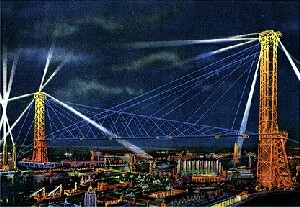|
The Chicago World Exposition 1933 & 1934
Progress and benefits - the science exhibition
|
Year: | 1933 | | City: | Chicago | | Country: | USA | | Duration: | 27th May - 12th November 1933 und 25th M |
|
1
| 
Copyright: |
|
The exposition of Sciences
The goal of the exhibition in the Hall of Science was to emphasize the significance of research and demonstrate its impact on the economy and day-to-day life. Already during the run-up to the fair a broad public relations campaign – with a magazine that was established specifically for the fair, special radio programmes on science and provision of material for the international press – ensured that there was a receptive public.
The Science Advisory Committee (SAC) wanted to achieve five goals: They wanted to demonstrate the most important sciences and their methods and depict outstanding phenomena and discoveries. The interdependencies between modern life and industrial development were demonstrated in that new products, such as fridges, were not shown as isolated objects but in an ideal home context. And, finally fairgoers were intended to find a way from ignorance and arrogance with regard to science to recognition of scientific methodology.
On the advice of the SAC, the organizers of the fair had educational films, dioramas and slide shows produced to convey impressions of the sciences. The impact of applied science on business itself was shown, with a committee simply making sure that no exhibits were shown twice.
This concept resulted in impressive presentations, with installations that people could walk through. In the chemical section, for instance, they could stroll through a huge, three-dimensional periodic classification of the elements. A globe suspended above this showed the main occurrences of the elements. In the medical section, a glass human being from the Hygiene Museum in Dresden gave an insight into the functioning of body organs. The humanities were also able to present their contribution to the development of mankind. In the Hall of Religions, for instance, there was a demonstration of how religions, with their socio-pedagogical activities, could provide a moderating response to the ever faster changes in the world.
The American automotive industry spent a considerable amount of money on impressing its contribution to progress on the public. General Motors built the largest company pavilion in which complete Chevrolets were assembled on a production line. Its competitor Chrysler, however, presented a 500-metre test track on which visitors were allowed to accompany famous racing and stunt drivers in cars. Faced with such attractions, the federal government could only come up with a military camp featuring cavalry and artillery which gave an insight into the training and drilling of soldiers. In the pavilion of the state of New York, the old rival of Chicago demonstrated its huge development potential with wall-high photographs by Edward Steichen.
At the same time the Art Institute of Chicago on Michigan Avenue organized a large art exhibition that participated in the profit generated by the Fair. A bus shuttle took visitors to the museum free of charge. The organizers of the fair thus saved themselves the effort and expense of building a fire-proof art palace without which it would have been impossible to borrow major works of art. Named "A Century of Progress in American Collecting", the exhibition showed outstanding works of art, primarily from private American collections. In the second season, in 1934, there was another exhibition in which American art was compared with European art, for instance Impressionism.
|



